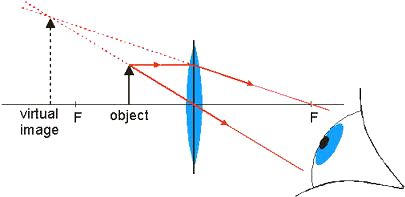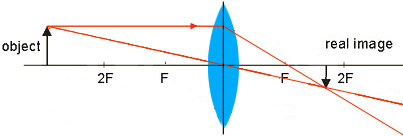If the rays of light cross when drawing your ray diagrams then the image is real. This image can be projected onto a screen and be seen. An example of this is the image produced by the lens on an overhead projector.

| Real Image: If the rays of light cross when drawing your ray diagrams then the image is real. This image can be projected onto a screen and be seen. An example of this is the image produced by the lens on an overhead projector. |
 |
 |
Virtual Image: A virtual image is an image where the rays of light do not cross and must be traced back to the other side of the lens or mirror. The point at which these lines meet is where the observer will believe the image is located. The image does not really exist and can not be projected onto a screen. An example of this is the image produced when looking through a magnifying glass. |
| Diminished Image: If the image produced is smaller than the original object, the image is called dimished. An example of this is an object placed far from a convex lens. |
 |
 |
Magnified Image: If the image is larger than the original object it is called magnified. An example of this is an object that is placed very close to a convex lens. (inside the focal point) This is why convex lenses are used for "magnifying glasses". These two diagrams also demonstrate why the magnifying glass needs to be close to the object being viewed. |
| Inverted Image: If the image is formed on opposite side of the principle axis as the object it is said to be inverted. All real images formed by lenses or mirrors are inverted. The reason your overhead projector projects its image onto a flat mirror before projecting it onto a screen is to flip the image - making it "right side up" to you the observer. It is also possible for virtual images to be inverted. |
 |
 |
Erect Image: If the image is formed on the same side of the principal axis as the object it is said to be erect. This happens for virtual images produced by lenses and mirrors, but not all virtual images will be erect. |